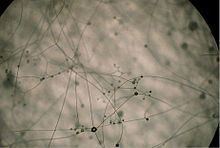Kingdom Fungi Division Zoopagomycotina | Higher classification Fungus | |
 | ||
Similar Kickxellomycotina, Mucoromycotina, Zoopagales, Neocallimastigomycota, Blastocladiomycota | ||
The Zoopagomycotina are a subdivision (incertae sedis) of the fungal division Zygomycota sensu lato. It contains 5 families and 20 genera. Relationships among and within subphyla of Zygomycota are poorly understood and their monophyly remains in question so they are sometimes referred to by the informal name, “zygomycetes”.
Contents
Zoopagomycotina are microscopic and they are typically obligate parasites of other zygomycete fungi and of microscopic soil animals such as nematodes, rotifers, and amoebae. Some species are endoparasites that live mostly within the bodies of their hosts and only exit the host when they are producing spores. Other species are ectoparasites (e.g. Syncephalis, Piptocephalis) that live outside of the host body, but produce specialized organs called haustoria that penetrate inside of the host body to capture host nutrients. Similar haustoria are found in biotrophic plant, animal, and fungal pathogens in several other major fungal lineages.
Like most other zygomycete fungi, the Zoopagomycotina have cell walls containing chitin and they have coenocytic (nonseptate) hyphae. Their vegetative body consists of a simple, branched, or unbranched thallus. Asexual reproduction is by arthrospores (in Helicocephalum), chlamydospores, uni- or multi-spored sporganiola; sporangiospores of multi-spored formed in simple or branched chains (merosporangia), usually from a vesicle or stalk. Many produce haustoria. Where observed, the sexual spores (zygospores) are globose and unornamented. The hyphae used during sexual outcrossing is similar to vegetative hyphae or in some cases may be slightly enlarged.
Etymology
The word Zoopagomycotina comes from the Greek roots zoo meaning “animal” and pag meaning “rock” or “ice/frost.”
Evolutionary Relationships
Although great strides have been made in resolving the evolutionary relationships among many lineages of fungi it has been challenging to resolve relationships within and among zygomycetes. For example, the uncertain grouping of Zoophagus insidians with the Kickxellomycotina.
Resolving a well-supported monophyly of the Zoopagomycotina has been particularly challenging for several main reasons: 1) most species of Zoopagomycotina are microscopic and challenging to observe, 2) most species of Zoopagomycotina cannot be grown separately from their host organisms in axenic culture, so obtaining pure DNA for molecular studies is challenging, and 3) based on ribosomal DNA sequences, species of Zoopagomycotina may have undergone accelerated evolution, so grouping may be skewed by long-branch attraction (LBA) and a high frequency of parallel evolutionary changes.
Families and their respective genera
Cochlonemataceae
Helicocephalidaceae
Piptocephalidaceae
Sigmoideomycetaceae
Zoopagaceae
